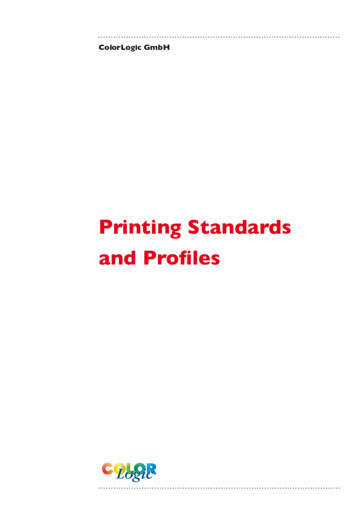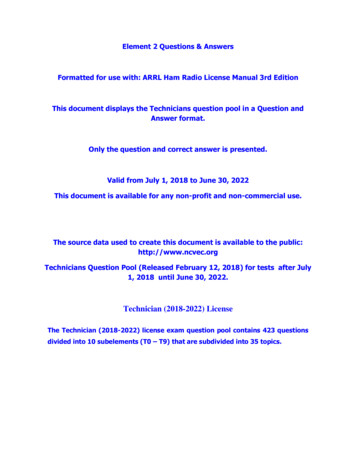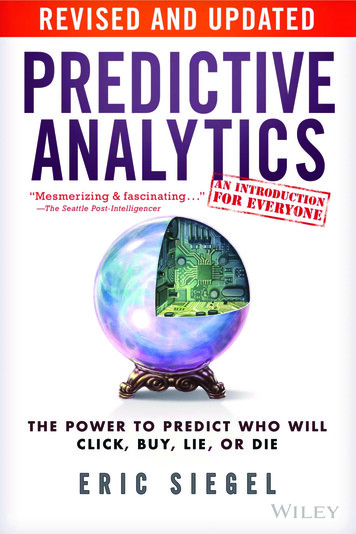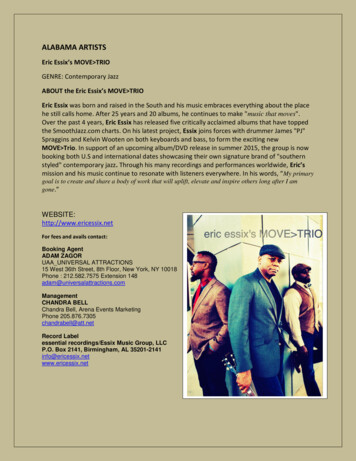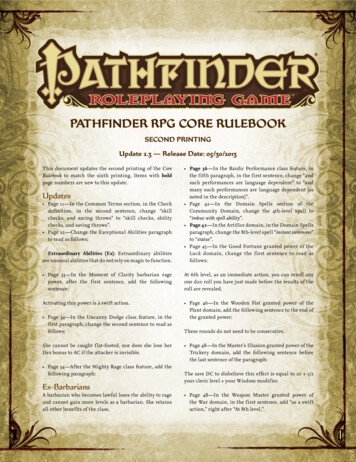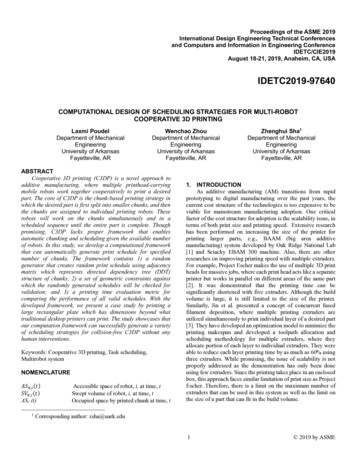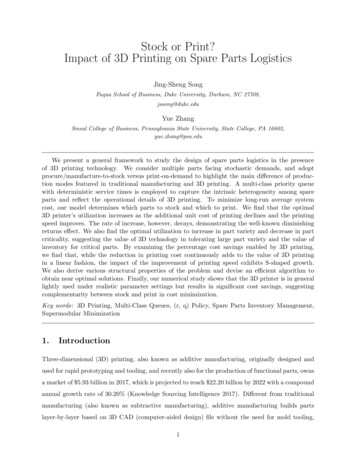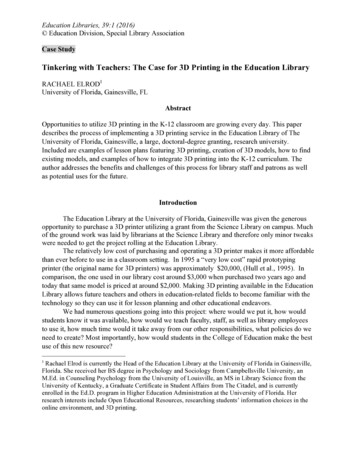
Transcription
Education Libraries, 39:1 (2016) Education Division, Special Library AssociationCase StudyTinkering with Teachers: The Case for 3D Printing in the Education LibraryRACHAEL ELROD1University of Florida, Gainesville, FLAbstractOpportunities to utilize 3D printing in the K-12 classroom are growing every day. This paperdescribes the process of implementing a 3D printing service in the Education Library of TheUniversity of Florida, Gainesville, a large, doctoral-degree granting, research university.Included are examples of lesson plans featuring 3D printing, creation of 3D models, how to findexisting models, and examples of how to integrate 3D printing into the K-12 curriculum. Theauthor addresses the benefits and challenges of this process for library staff and patrons as wellas potential uses for the future.IntroductionThe Education Library at the University of Florida, Gainesville was given the generousopportunity to purchase a 3D printer utilizing a grant from the Science Library on campus. Muchof the ground work was laid by librarians at the Science Library and therefore only minor tweakswere needed to get the project rolling at the Education Library.The relatively low cost of purchasing and operating a 3D printer makes it more affordablethan ever before to use in a classroom setting. In 1995 a “very low cost” rapid prototypingprinter (the original name for 3D printers) was approximately 20,000, (Hull et al., 1995). Incomparison, the one used in our library cost around 3,000 when purchased two years ago andtoday that same model is priced at around 2,000. Making 3D printing available in the EducationLibrary allows future teachers and others in education-related fields to become familiar with thetechnology so they can use it for lesson planning and other educational endeavors.We had numerous questions going into this project: where would we put it, how wouldstudents know it was available, how would we teach faculty, staff, as well as library employeesto use it, how much time would it take away from our other responsibilities, what policies do weneed to create? Most importantly, how would students in the College of Education make the bestuse of this new resource?1Rachael Elrod is currently the Head of the Education Library at the University of Florida in Gainesville,Florida. She received her BS degree in Psychology and Sociology from Campbellsville University, anM.Ed. in Counseling Psychology from the University of Louisville, an MS in Library Science from theUniversity of Kentucky, a Graduate Certificate in Student Affairs from The Citadel, and is currentlyenrolled in the Ed.D. program in Higher Education Administration at the University of Florida. Herresearch interests include Open Educational Resources, researching students’ information choices in theonline environment, and 3D printing.
Education Libraries, 39:1 (2016) Education Division, Special Library AssociationLiterature ReviewWhile we did not locate any peer-reviewed articles specifically discussing 3D printing ina stand-alone Education Library, there are many articles that discuss 3D printing in academiclibraries in general, in K-12 settings, and in public libraries. This literature review discusses 3Dprinting as it relates to academic libraries and the K-12 environment.The 2015 NMC Horizon Report K-12 includes a section on 3D printing which outlinesthe applicability of 3D printing to teaching and learning in K-12 education. NMC estimates that3D printing will be standard in schools within the next two to three years. From a high school inMaine using 3D printing to create art pieces based on a graphic novel to a school in Taipei thatuses 3D printing to teach students engineering skills, the use of 3D printing is growing in K-12education. However, for 3D printing to continue to grow in this environment, “adequate trainingis needed to ensure teachers and students have the digital competency needed to turn their ideasinto reality” (NMC Horizon Report, 2015, p. 41).Ambitions are high for 3D printing in the K-12 classroom. MakerBot Academy has aproposal to put a MakerBot 3D printer in every school in America and provide relatededucational content (MakerBot Academy). In addition, “the Chinese government has creatednew policy that will install a 3D printer in nearly 400,000 schools over the next two years”(NMC Horizon Report, 2015, p. 41).In 2012, the first University Library to offer 3D printing was the DeLaMare Science &Engineering Library at the University of Nevada-Reno (Free, 2012). However, SPEC Kit 348states “the ARL survey results make clear that the broad appeal of these technologies extendsbeyond technology-focused universities” (Association of Research Libraries, 2015).One researcher noted that “an anticipated problem with expanding 3D printingtechnology to disciplines other than engineering was the students in those disciplines may nothave the CAD [computer aided design] expertise to create a digital model from scratch insoftware” (Pryor, 2014). The Education Library has addressed this issue by directing students to3D Printing LibGuides with information on using existing 3D models, creating 3D models, andby offering workshops that provide an introduction 3D printing technologies.Some University Libraries have purchased 3D printers for the specific purpose of makingthem available to academic units not typically thought of. The Dalhousie Libraries in Canadapurchased 3D printing technologies “to encourage the use of these technologies by academicunits not traditionally associated with them, such as Biology, Chemistry, Physics, Mathematics,History, and Theatre” (Groenendyk and Gallant, 2012).The use of 3D printing in the K-12 environment is still new but teachers are alreadydeveloping ideas and beginning to implement them. An elementary school in Tennesseepurchased a 3D printer and challenged the kindergarten and first grade students to design a newpiece of playground equipment. At the end of the project, the playground equipment wasinstalled in their playground. The authors noted that the project could have been improved byincluding preservice teachers who were knowledgeable about 3D printing: “Preservice teacherscould be prepared for this type of project by replicating the process in the college classroom.
Education Libraries, 39:1 (2016) Education Division, Special Library AssociationThey would understand and be able to implement the project in many settings, but having theexperience and knowledge would prepare them for the classroom” (Wendt & Wendt, 35).At a middle school in North Carolina, students in Art class are learning to use Tinkercadand Thingiverse to design and download 3D models such as “key chains, nametags, and otherdesigns such as small houses” and in the future they will “create Chinese calligraphy seals in anAsian art lesson, as well as stop-motion puppets” (Moorefield, 2014). Meanwhile, a middle andhigh school Librarian in North Carolina is teaming up with another Art teacher for a steampunksculpture project (Moorefield, 2014).One ambitious educator references Star Trek when explaining 3D printing saying, “ifstudents aboard the starship Enterprise were studying the organelles of a cell during a biologylesson, they might use the “replicator” to actually build a large model of a cell in threedimensions Turns out the replicator-otherwise known as a 3D printer-is already here” (Horejsi,10). He goes on to predict additional uses saying that, “digital textbooks, with some tweaks,could be linked to a 3D printer so that topics covered literally materialize off the screen,”(Horejsi, 10).What is 3D Printing?3D printing is an example of additive manufacturing, where objects are created by layingdown layer upon layer of filament until an object is formed on the x, y, and z axes. 3D modelsare created using CAD (computer aided design) software programs such as Tinkercad. 3Dmodels can also be created by using scanners to scan an object that can be downloaded as a 3Dmodel. An app called 123D Catch can be downloaded free to your smart phone and can create a3D model after taking a series of photos in small increments around the object. There is also aproduct called iSense which can be attached to an iPad and create a 3D design by walkingaround the object you wish to capture.Setting up the printerWe knew from another campus library primarily serving the sciences that the printerneeded placement where it would not be physically disturbed. From early use at the ScienceLibrary we knew that even a strong breeze coming through a nearby door could affect theprinting. We purchased a MakerBot Replicator 2 and had a clear plexiglass container built tohouse the printer to protect it from environmental disturbances.At first, the printer was placed on the Circulation Desk but after several failed prints webecame concerned that perhaps it was too draughty there and placed it on a table behind theCirculation Desk. It was a little better but there were still some errors in the prints so a clearplexiglass shield was built to protect the printer from breezes either from the front door or peoplewalking briskly by the machine. Once we put the plexiglass shield in place the prints were errorfree.Leveling the build plate, the part of the printer where the print is actually built, can beone of the hardest parts of getting the 3D printer set up. This ensures that the extruder isextruding the filament at the same distance at all levels during the build. The extruder for theMakerBot travels to the four corners of the build plate thick piece of paper to slide in between
Education Libraries, 39:1 (2016) Education Division, Special Library Associationthe build plate and tip of the extruder nozzle. All four corners should feel like there is a justenough room to slide the paper in between without being too loose or too tight.Organizing all of the tools required for 3D printing can be a challenge as well. Wedecided to purchase an Airwolf 3D Printer Cart, but we are still using a book cart to store ourextra filament. The advantage to having the printer on a cart, is that we can wheel it to the libraryclassroom for demonstrations during our 3D printing workshops. Our future goals are to createan enclosed room that will include storage space for filament, tools, and a place to store finishedprints waiting to be picked up. The 3D printer and filament cart currently sit behind theCirculation Desk.Useful tools to have on hand include: pliers and tweezers for pulling off supports, smalland large plastic baggies for putting finished prints in along with the patrons name, a ruler, flashdrives, SD cards, a scale to measure how much filament is left on the roll, a small level to aid inleveling the build plate, a scraper to help get the print off the build plate, and scissors.Figure 13D Printing ToolsFigure 2MakerBot Replicator 2 with plexiglass case
Education Libraries, 39:1 (2016) Education Division, Special Library AssociationFigure 3MakerBot on AirWolf 3D Printer Cart.Figure 4Filament rolls stored in plastic baggies with a silicone gel pack inside to keep the filament fresh.TemperatureManufacturers suggest filament temperature setting depending on the type of materialsand the color of the filament. We found that suggested temperatures do not always print the bestand a system of trial-and-error helped us determine the ideal temperature setting to use. For ourMakerBot Replicator 2 using PLA filament, we found that the ideal temperature setting is 225degrees Celsius for white filament, 220 degrees Celsius for color filament (black, white, red,green, blue, etc.), and 210 degrees Celsius for glow-in-the-dark, natural, and wood filament.SafetyThe extruder and nozzle of 3D printers generate high temperatures and should never betouched before cooling down. Once the equipment begins printing, the extruder can moverapidly in several directions inside the build area so it is best to make sure the print is completebefore removing the printed object. PLA plastic while not toxic, does produce an odor and may
Education Libraries, 39:1 (2016) Education Division, Special Library Associationbother people in the vicinity of the area so it is recommended to keep the printer in a wellventilated area.FilamentThere are many types of materials that can be used for 3D printing. Due to cost, the mostcommonly used material in libraries is plastic filament. There are two types of plastic that can beused in 3D printing; ABS (acrylonitrile butadiene styrene) and PLA (polylactic acid). ABSplastic is the type used in LEGOs . It is a more durable material but the downside is that thefumes or odors produced when melting the plastic can be toxic. We use PLA filament, whichrepresents a lesser health and safety risk than ABS (University of Florida, Environmental Health& Safety, 2016).With either type of plastic filament it is important to have your 3D printer in a wellventilated area to mitigate any fumes from the melting plastic. The University of Florida’s 3DPrinter Policy requires that there be no more than “one printer per standard office and no morethan two printers for a standard classroom or workroom” (University of Florida, EnvironmentalHealth & Safety, 2016).Filament comes in a variety of colors and textures. Students have the option of choosing acolor such as blue, green, red, etc. or even glow-in-the-dark. Another option is to print using astandard white filament, which can then be colored using paint or enamel. One of the moreexotic filaments we provide is wood. It is a combination of plastic and pine shavings that givethe finished project the look of a wooden item.RaftA raft is the horizontal layer of filament that is printed beneath the object to providestability and a foundation during the printing process. It is not always necessary to print a raft butthe option is available to choose it or not. In the example below, a raft is being used to connect acollection of ancient horse teeth. The object(s) can be easily removed from the raft when theprint is complete.Figure 5Raft holding horse teeth
Education Libraries, 39:1 (2016) Education Division, Special Library AssociationFigure 6Raft holding horse teeth.SupportsFor print jobs with parts that have nothing below it (like an overhang), a support can beprinted that will assist that part of the print during the printing process. Imagine printing theletter “T” standing up straight. Without supports there will be nothing to hold the arm of theletter therefore supports are needed to keep it sturdy during the printing process. In some cases,the need for supports can be alleviated by laying the object down flat but that is not alwayspossible for more complex forms.The supports are weaker than the actual printed portion of the model and can easily betaken off once the print is complete. The supports can sometimes be taken off by hand and othertimes require tools such as tweezers or pliers. Once supports are removed it is sometimesnecessary to use other tools such as an emery board or nail file to smooth the places where thesupports were connected.Below are examples of a triceratops made on a Fusion printer from a Thingiverse model(Triceratops) before and after supports were removed. Notice that the underside of the finishedmodel has a rough appearance from where the supports were connected. This can be smootheddown using a nail file if desired.
Education Libraries, 39:1 (2016) Education Division, Special Library AssociationFigure 7With supports, side view.Figure 8Supports removed, side view.Figure 9With supports, bottom view
Education Libraries, 39:1 (2016) Education Division, Special Library AssociationFigure 10Supports removed, bottom view.Submitting a 3D Printing JobAt this time, our faculty, students, staff, and the general public submit their 3D print jobsin person at the library by bringing a .stl (stereolithographic or Standard Tessellation Language)file on a flash drive to the service desk. If the job is deemed simple, it can be acceptedimmediately. If it is complex or raises questions we set an appointment with the student toexamine the design file more closely to increase the odds of a successful printing.Students must sign an agreement (Appendix A) stating that they agree to adhere to theUniversity’s Computer Use Policy and copyright regulations. The student is given a cost estimateand payment is made by major credit card or debit card online. Prints that fail because of astudent error are not reimbursed. However, students whose prints fail due to machine or librarystaff error will receive a voucher for future printing.Students are given an estimate, but not a guarantee, of when their printed object may beready and are sent an email when the job has finished and ready for retrieval. Priority is given toUniversity students, faculty, and staff, and printing jobs for a class assignment.Printing CostThe initial cost of printing a 3D object at the Library was set at 0.06/gram 0.02/minute as determined by Makerware, with a 3.00 minimum charge. After the libraries oncampus purchased additional 3D printers that printed at varying speeds this was changed to a flatrate of 0.15/gram. Several small objects can be batched together to meet the 3.00 minimumrequirement. Most items under 1.5” x 1.5” are 3.00. An object around 6.5” x 3.5” costs around 20.00.
Education Libraries, 39:1 (2016) Education Division, Special Library AssociationMaking the Case for 3D Printing in the Education LibraryWhat makes 3D printing educational objects special is the ability to customize the 3Dprint models to adjust to any specific curriculum needs. Prefabricated objects can often beexpensive, may not fit the exact needs of the lesson, and may include a kit with objects thataren’t needed. Whereas, 3D printed objects, created and designed by the instructor, will be aperfect fit. 3D models can also be modified to fit a school’s limited budget.Using CAD software, such as TinkerCAD or AutoDesk, objects can be customized. Theteacher can create objects that cause students to think and provide an opportunity to excitestudents in their learning.There are several websites that include lesson plans using 3D printing. Thingiverse has awebsite of 3D models related to Education in its Curriculum collection (ThingiverseCurriculum). Their website features lesson plans for teachers using 3D printing in content areasof math, science, social studies, fine arts, and maps. Many of these lesson plans includeinstructions for use in a variety of classroom settings and information on Common Core andother related standards.Other websites that have lesson plans and/or have tied-in 3D printing to the CommonCore Standards include PaleoTEACH, MorphoSource, and the Smithsonian. PaleoTEACH existsto provide “high quality 3D models of fossils to a K12 audience and a set of lessons inconnection with 3D models,” (PaleoTEACH).MorphoSource is a collection of 3D morphological datasets which is not specific to K-12but does include some lesson plans, available in the Project section of the website, on topics suchas human evolution, horse evolution, megalodons, and a lesson on base-ten conversions usingscans of fossilized mammalian teeth (MorphoSource).The Smithsonian has a website devoted to 3D printing that includes a link especially foreducators (Smithsonian). This website includes 3D models of scanned artifacts from theSmithsonian collection such as the life mask of Abraham Lincoln which includes a free eBookthat can be downloaded on iPad, iPhone, and MAC, discussing Lincoln in more detail (The Mindbehind the Mask).SummaryThe Education Library began offering 3D Printing on January 2nd, 2015. In the first sixmonths of printing we executed 116 print jobs, using nearly 11 kilograms of filament, and 770hours of printer time. The average printed object weighed 94 grams and cost 13.63.Table 1Summary of 3D Printer Usage for the first six months# Prints# GramsAverage grams/print# of minutes printedPatron consult timeConsult time/printAverage cost/printAverage print time/request11610,955.994 (@ 0.2 pounds)46,241 minutes (770 hours: 41 minutes)1,131 minutes (18 hours: 51 minutes)9.75 minutes 13.63398 minutes (6 hours: 38 minutes)
Education Libraries, 39:1 (2016) Education Division, Special Library AssociationConclusionWith opportunities for 3D printing in the K-12 classroom continuing to grow, we predictthat the demand for the printer will also continue to grow. Based on initial demand andsuccessful integration we plan to continue offering 3D printing and enhance it by acquiringcomplementary equipment such as portable 3D scanners for use with iPads, developing arepository of lesson plans, and marketing to our primary library constituents: education faculty,students, and staff. In addition, the library is planning to host a series of workshops to introduceeducation faculty, students, and staff to 3D printing concepts.Acknowledgments: The 3D Printing program at the Libraries was funded by a competitiveUniversity Technology Fee Grant and the hard work of the following individuals: Sara Gonzalez,Amy Buhler, Denise Bennett, Tara Cataldo, Michael Howell, Margeaux Johnson, VernonKisling, Michelle Leonard, Ann Lindell, Valrie Minson, Cliff Richmond, Melody Royster,Hannah Norton, Don David, Christine Yip, Christine Cogar, Josh Spurgin, and Evan Wack.
Education Libraries, 39:1 (2016) Education Division, Special Library AssociationReferencesAssociation of Research Libraries. (2015). Rapid fabrication/Makerspace services: SPEC kit.Washington, D.C: Association of Research Libraries, Office of Leadership andManagement Services.3D Printing Industry. The Free Beginner's Guide - History. (n.d.). Retrieved July 01, 2016, cs-free-beginners-guide/history/Free, D. (2012). University of Nevada-Reno library offers 3-D printing. College & ResearchLibraries News, 73(8), 455.Groenendyk, M., & Gallant, R. (2012). 3D printing and scanning at the Dalhousie UniversityLibraries: a pilot project. Library Hi Tech, 31, 34-41. doi: 10.1108/07378831311303912Horejsi, M. (2014). Teaching STEM with a 3D printer. Science Teacher, 81(4), 10.Hull, C., Feygin, M., Baron, Y., Sanders, R., Sachs, E., Lightman, A., & Wohlers, T. (1995).Rapid prototyping: Current technology and future potential. Rapid Prototyping Journal,1(1), 11-19. Retrieved ccountid 10920MakerBot Academy. (n.d.) Retrieved October 2, 2015, from http://www.makerbot.com/academy.Moorefield-Lang, H. (2014). 3-D printing in your libraries and classrooms. Knowledge Quest,43(1), 70- 72.MorphoSource. (n.d.) Retrieved September 30, 2015, from http://morphosource.org/.NMC Horizon Report: 2015 K-12 Edition. (2015, August 18). Retrieved October 2, 2015, rt-k12-EN.pdfPaleoTEACH STEAM integration through paleontology & 3D technology. (n.d.) RetrievedSeptember 30, 2015, from www.paleoteach.org.Pryor, S. (2014). Implementing a 3D printing service in an academic library. Journal of LibraryAdministration, 54, 1-10. doi: 10.1080/01930826.2014.893110Smithsonian Educators. (n.d.). Retrieved September 30, 2015, fromhttp://3d.si.edu/article/educatorsThe Mind behind the Mask. (n.d.). Retrieved September 30, 2015, ind-the-mask/id99062104?mt 13Thingiverse Curriculum. (n.d.). Retrieved September 30, 2015, iceratops. (n.d.). Retrieved September 30, 2015, ity of Florida, Environmental Health & Safety (2016). 3D Printer Policy. Retrieved policy/Wendt, S. s., & Wendt, J. (2015). Printing the Playground. Science & Children, 52(5), 43-47.
Education Libraries, 39:1 (2016) Education Division, Special Library AssociationAppendixUser Agreement“I acknowledge that my item(s) adhere to copyright restrictions and to UF’s computer usepolicies. I understand that the Libraries reserve the right to decline a print request that does notcomply.I understand that I will not be reimbursed for jobs that failed on my part, but I will receive avoucher for jobs that fail on the library’s part.I understand that the Libraries cannot guarantee a print time, however staff may be able toprovide an estimate based upon the print queue length.I understand that priority is given to UF students, faculty, and staff, and also to classassignments.I understand that items printed that are not picked up within 14 days become the property of theLibraries. Items must be picked up by the individual who printed them.”
Ambitions are high for 3D printing in the K-12 classroom. MakerBot Academy has a proposal to put a MakerBot 3D printer in every school in America and provide related educational content (MakerBot Academy). In addition, “the Chinese government has created new policy that will install a 3D printer
